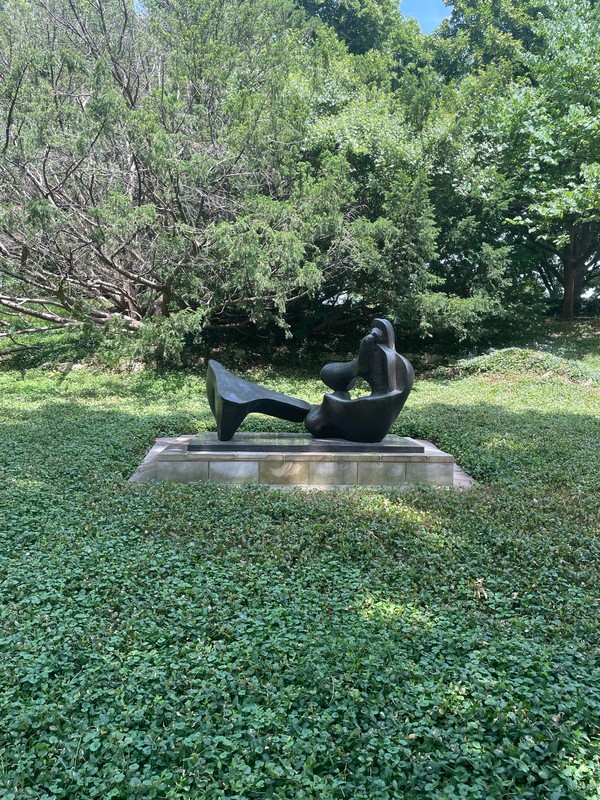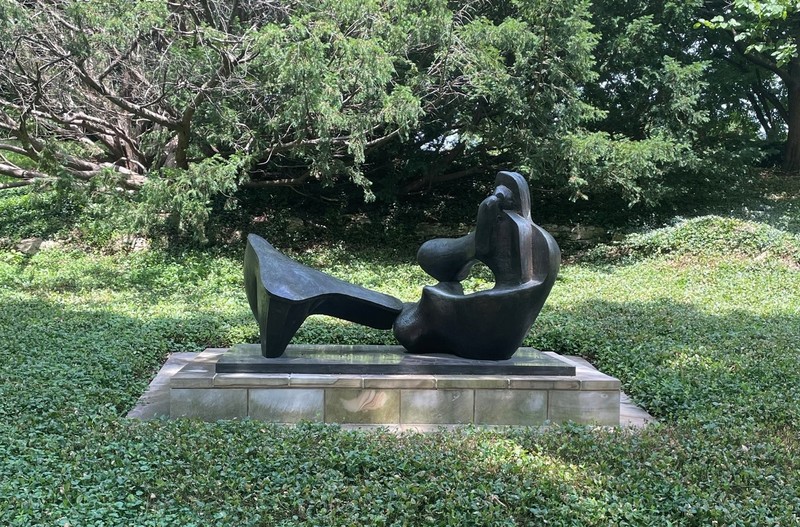Two Piece Reclining Figure No. 9
Introduction
Text-to-speech Audio
The juxtaposition of the two figural shapes in this bronze sculpture creates the appearance of a reclining human figure, a common form seen in Henry Moore's work. Created in 1968, Two Piece Reclining Figure No. 9 was the ninth of this two-piece series but the first in which the two pieces are touching. The eight-foot long sculpture retains the form of Moore’s typical reclining figure as the two separate pieces come together to form one entity, yet offer opposing characteristics. Likely inspired by a bone fragment from his studio, the vertical, upper body is curvaceous and smooth, while the horizontal leg piece is more rigid with fine lines that give the form texture.
Images
Two Piece Reclining Figure No. 9 by Henry Moore at the Nelson-Atkins Museum of Art, Kansas City, Missouri

A closer view of Two Piece Reclining Figure No. 9

Backstory and Context
Text-to-speech Audio
Comprising two-thirds of his work, the reclining figure is one of Henry Moore’s most used forms as he was largely interested in the characteristics and movement of the human body. Until the 60s he typically sculpted these figures as one piece, in which he then started to experiment with size and abstraction, including dividing his forms into two and three piece compositions to create both juxtaposition and interdependence of space and proportion. However, Moore admitted that he unintentionally created a number of smaller, multi-piece abstract sculptures as early as 1934, which he kept in the back of his mind for some time. In a later reflection he stated, “I realized what an advantage a separated, two-piece composition could have … Once these two parts become separated, you don’t expect it to be a naturalistic figure.”
One of the first modern sculptures acquired for their personal home collection, Two Piece Reclining Figure No. 9 (cast 3/ed. 7) was originally owned by Patsy and Raymond Nasher, avid art enthusiasts from Dallas. The work was later obtained by the Hall Family Foundation and gifted to the Nelson-Atkins Museum of Art.
Gallery Label
Henry Moore made a number of figural sculptures based on the combination of two separate components as in Two-Piece Reclining Figure No. 9. He believed that two-part compositions suggested new ways of relating the figure to the landscape: "Once these two parts become separated, you don't expect it to be a naturalistic figure; therefore, you can more justifiably make it like a landscape or a rock. If it is in two pieces, there's a bigger surprise, you have more unexpected views." Two-Piece Reclining Figure No. 9 offers the unexpected juxtaposition of undulating, swelling forms in contrast to planar surfaces.
Sources
Museum Label, Two-Piece Reclining Figure No. 9, Nelson-Atkins Museum of Art. Accessed July 7th 2022.
Two-Piece Reclining Figure No. 9, The Nelson-Atkins Museum of Art. Accessed September 13th, 2022. https://art.nelson-atkins.org/objects/10305/twopiece-reclining-figure-no-9.
Alice Correia, ‘Two Piece Reclining Figure No.9 1968, cast c.1968–70 by Henry Moore OM, CH’, catalogue entry, February 2014, in Henry Moore: Sculptural Process and Public Identity, Tate Research Publication, 2015. Accessed September 13th, 2022. https://www.tate.org.uk/art/research-publications/henry-moore/henry-moore-om-ch-two-piece-reclining-figure-no9-r1172007.
Photo by David Trowbridge
Photo by David Trowbridge (cropped)
